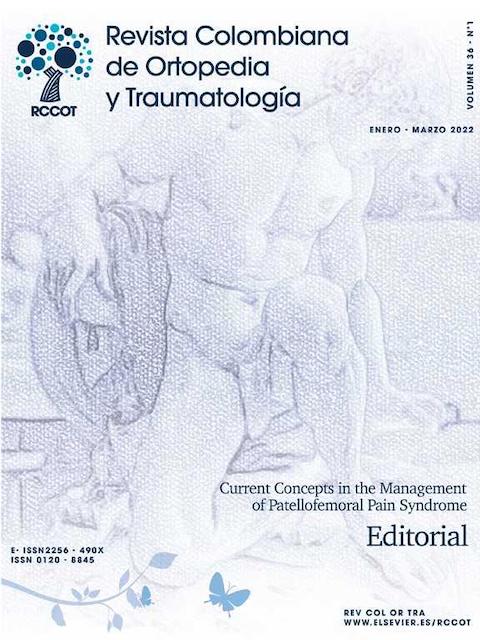A comparison of sutures for deep and superficial wound closure in total knee arthroplasty: One-year follow-up
DOI:
https://doi.org/10.1016/j.rccot.2022.04.006Keywords:
arthroplasty knee replacement, surgical wound dehiscence, surgical wound infection, sutures, wound closure techniquesAbstract
Introduction: Different materials and techniques have been developed for superficial and deep closure in total knee replacement (TKR), but there is no solid evidence that allows to recommend a specific technique that decreases the surgical post-operative complications. The purpose of this study is to compare the use of two deep closure techniques (barbed suture vs. braided absorbable suture) and superficial (staples vs. polypropylene suture) in TKR.
Materials and methods: An observational retrospective study was carried out in 240 patients. Those individuals were excluded with previous open knee surgery, arthrofibrosis, patients who underwent TKR due to tumor lesions or a follow up for less than one year.
Results: The skin was closed in 176 patients with staples and in 64 patients with Prolene®. Deep closure was performed with Stratafix® in 164 patients and with Vicryl® in 75 patients. Also, complications related to the wound and functionality were recorded in the first postoperative year. Superficial infection for closure with prolene presented an HR in favor of 2.6 with a confidence interval (CI) of 95% = 1.1-6.2; p = 0.029 and in deep closure a HR in favor of Vicryl® of 0.22, 95% CI = 0.96-5.8; p = 0.05
Conclusions: This study demonstrated a significant increase in the incidence of superficial infection after TKR when deep closure is performed with barbed sutures and superficial closure with polypropylene suture. However, there were no significant differences in other complications related with the wound neither postoperative functionality with the different superficial and
deep closure techniques that were evaluated.
Downloads
References
Pitta M, Esposito CI, Li Z, Lee Y, yu, Wright TM, Padgett DE. Failure After Modern Total Knee Arthroplasty: A Prospective Study of 18,065 Knees. J Arthroplasty. 2018, http://dx.doi.org/10.1016/j.arth.2017.09.041.
Delanois RE, Mistry JB, Gwam CU, Mohamed NS, Choksi US, Mont MA. Current Epidemiology of Revision Total Knee Arthroplasty in the United States. J Arthroplasty. 2017, http://dx.doi.org/10.1016/j.arth.2017.03.066.
Al-Houraibi RK, Aalirezaie A, Adib F, Anoushiravani A, Bhashyam A, Binlaksar R, et al. General Assembly, Prevention, Wound Management: Proceedings of International Consensus on Orthopedic Infections. J Arthroplasty. 2019, http://dx.doi.org/10.1016/j.arth.2018.09.066.
Moucha CS, Clyburn TA, Evans RP, Prokuski L. Modifiable risk factors for surgical site infection. Instr Course Lect. 2011.
Mangram AJ, Horan TC, Pearson ML, Silver LC, Jarvis WR. Guideline for Prevention of Surgical Site Infection, 1999, Centers for Disease Control and Prevention (CDC) Hospital Infection Control Practices Advisory Committee. Am J Infect Control. 1999.
Parvizi J, Zmistowski B, Berbari EF, Bauer TW, Springer BD, Della Valle CJ, et al. New definition for periprosthetic joint infection: From the workgroup of the musculoskeletal infection society. Clin Orthop Relat Res. 2011, http://dx.doi.org/10.1007/s11999-011-2102-9.
Kim J, Nelson CL, Lotke PA. Stiffness after total knee arthroplasty: Prevalence of the complication and outcomes of revision. J Bone Jt Surg - Ser A. 2004, http://dx.doi.org/10.2106/00004623-200407000-00017.
Martín-Fernández J, García-Maroto R, Sánchez-Jiménez FJ, Bau-González A, Valencia-García H, Gutiérrez-Teira B, et al. Validation of the Spanish version of the Oxford knee score and assessment of its utility to characterize quality of life of patients suffering from knee osteoarthritis: A multicentric study. Health Qual Life Outcomes. 2017, http://dx.doi.org/10.1186/s12955-017-0761-2.
Kobayashi S, Niki Y, Harato K, Udagawa K, Matsumoto M, Nakamura M. The effects of barbed suture on watertightness after knee arthrotomy closure: A cadaveric study. J Orthop Surg Res. 2018, http://dx.doi.org/10.1186/s13018-018-1035-3.
Vakil JJ, O’Reilly MP, Sutter EG, Mears SC, Belkoff SM, Khanuja HS. Knee Arthrotomy Repair With a Continuous Barbed Suture. A Biomechanical Study. J Arthroplasty. 2011, http://dx.doi.org/10.1016/j.arth.2010.07.003.
Ting NT, Moric MM, Della Valle CJ, Levine BR. Use of Knotless Suture for Closure of Total Hip and Knee Arthroplasties. A Prospective. Randomized Clinical Trial. J Arthroplasty. 2012, http://dx.doi.org/10.1016/j.arth.2012.05.022.
Gililland JM. Barbed versus standard sutures for closure in total knee arthroplasty: a multicenter prospective randomized trial. J Arthroplasty. 2014, http://dx.doi.org/10.1016/j.arth.2014.01.041.
Smith EL, DiSegna ST, Shukla PY, Matzkin EG. Barbed versus traditional sutures: Closure time, cost, and wound related outcomes in total joint arthroplasty. J Arthroplasty. 2014, http://dx.doi.org/10.1016/j.arth.2013.05.031.
A.P. S. Is There an Advantage to Knotless Barbed Suture in TKA Wound Closure? A Randomized Trial in Simultaneous Bilateral TKAs. Clin Orthop Relat Res 2015.
Malhotra R, Jain V, Kumar V, Gautam D. Evaluation of running knotless barbed suture for capsular closure in primary total knee arthroplasty for osteoarthritis-a prospective randomized study. Int Orthop. 2017, http://dx.doi.org/10.1007/s00264-017-3529-8.
Zhang W, Xue D, Yin H, Xie H, Ma H, Chen E, et al. Barbed versus traditional sutures for wound closure in knee arthroplasty: A systematic review and meta-analysis. Sci Rep. 2016, http://dx.doi.org/10.1038/srep19764.
Austin DC, Keeney BJ, Dempsey BE, Koenig KM. Are Barbed Sutures Associated With 90-day Reoperation Rates After Primary TKA? Clin Orthop Relat Res. 2017, http://dx.doi.org/10.1007/s11999-017-5474-7.
Wright RC, Gillis CT, Yacoubian SV, Raven RB, Falkinstein Y, Yacoubian SV. Extensor mechanism repair failure with use of bidirectional barbed suture in total knee arthroplasty. J Arthroplasty. 2012, http://dx.doi.org/10.1016/j.arth.2011.08.013.
Chawla H, van der List JP, Fein NB, Henry MW, Pearle AD. Barbed Suture Is Associated With Increased Risk of Wound Infection After Unicompartmental Knee Arthroplasty. J Arthroplasty. 2016, http://dx.doi.org/10.1016/j.arth.2016.01.007.
Campbell AL, Patrick DA, Liabaud B, Geller JA. Superficial wound closure complications with barbed sutures following knee arthroplasty. J Arthroplasty. 2014, http://dx.doi.org/10.1016/j.arth.2013.09.045.
Krishnan R, MacNeil SD, Malvankar-Mehta MS. Comparing sutures versus staples for skin closure after orthopaedic surgery: Systematic review and meta-analysis. BMJ Open. 2016, http://dx.doi.org/10.1136/bmjopen-2015-009257.
Kim KY, Anoushiravani AA, Long WJ, Vigdorchik JM, Fernandez- Madrid I, Schwarzkopf R. A Meta-Analysis and Systematic Review Evaluating Skin Closure After Total Knee Arthroplasty-What Is the Best Method? J Arthroplasty. 2017, http://dx.doi.org/10.1016/j.arth.2017.04.004.
Meena S, Gangary S, Sharma P, Chowdhury B. Barbed versus standard sutures in total knee arthroplasty: a meta-analysis. Eur J Orthop Surg Traumatol. 2015, http://dx.doi.org/10.1007/s00590-015-1644-z.
Levine BR. CORR Insights®: Is There an Advantage to Knotless Barbed Suture in TKA Wound Closure? A Randomized Trial in Simultaneous Bilateral TKAs. Clin Orthop Relat Res. 2015, http://dx.doi.org/10.1007/s11999-015-4202-4.





